21 November, 2003
Sea Ice School
Due to its location and weather, Antarctica’s surrounding ocean water
freezes. This ice, which is very different from glaciers, is called sea
ice. Throughout the year the amount of sea ice waxes and wanes. When the
sea ice is at its maximum, the continent nearly doubles in size compared
to its minimum. About what time of year would the sea ice be at its
maximum? (Hint: Remember, we’re in the southern hemisphere!)
Besides temperature, other things affect the structure and stability of
the sea ice including: tidal pulls, ocean currents, icebergs, and pressure
from moving glaciers. Humans can also impact sea ice stability. How might
we have affected the sea ice? These activities put cracks in the ice. Too
much pressure and the crack increases, resulting in open water. As winter
progresses, cracks in the ice begin to “heal”, or refreeze. This new layer
of ice is much softer and therefore not as stable. The healing cracks,
often covered by blown in snow, result in an invisible danger to humans.
Many a people have fallen into the ocean when driving over or crossing a
healing crack. Therefore, anyone working on the sea ice, or on/near the
frozen lakes of the dry valleys must attend sea ice school. The goal is to
teach us the locations that are prone to problems and give us the skills
necessary to determine if it is safe to cross.
Sea ice that is less than 30 inches in depth is cause for concern. When
the sea ice depth is less than 30 inches, you can only safely travel 1/3
the distance of your vehicle’s track/footprint. If the thin ice spans a
distance that is larger than 1/3 of your vehicle's track, you need to find
an alternative route.
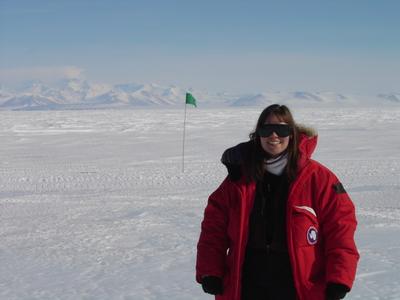
1. Standing on sea ice. Is this really solid land?
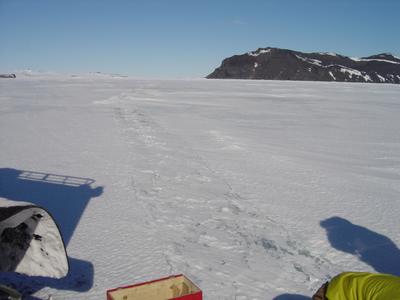
2. Here is a potential “soft spot”. Notice the two healing cracks. We need to check out the depth of the sea ice between these cracks.
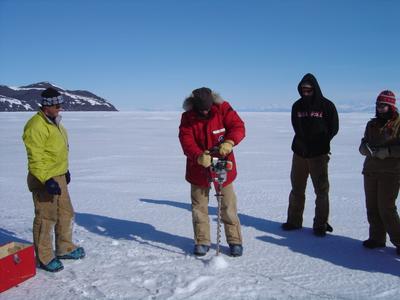
3. In order to determine the sea ice depth, we must drill down until we hit water. Our instructor Brian is teaching us to use the drill to penetrate the sea ice. We will drill holes perpendicular to the crack lines. (All the way across the soft spot) What do you think we need to do next?
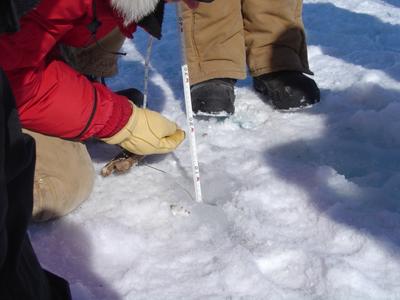
4. Next we must measure the depth down to the water. The lowest depth across the “soft spot” was 2 meters (78 inches) do we need to be concerned?

5. Today we drove out in a Pisten Bully. The size of its footprint is 6 feet. What’s the furthest distance it can safely cross over ice that is less than 30 inches deep?
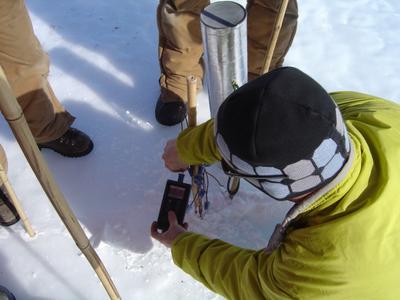
6. McMurdo staff must keep an eye on the waning sea ice. This instrument measures the temperature of the sea ice at various depths. How is sea ice temperature a good indication of sea ice stability?
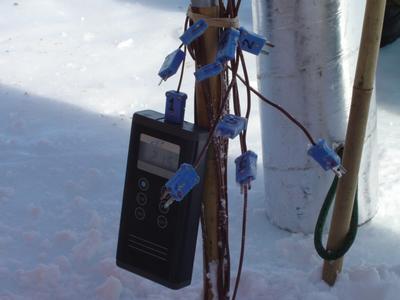
7. The numbers on the instrument indicate the depth in feet. What kind of temperatures would you expect this time of year? Will it be above 32F/0F? Predict how today’s temperatures would compare to temperatures taken two months ago, or to temperatures that will be taken next month. As the summer season progresses, do we need to monitor the sea ice more or less frequently?
Contact the TEA in the field at
.
If you cannot connect through your browser, copy the
TEA's e-mail address in the "To:" line of
your favorite e-mail package.
|
